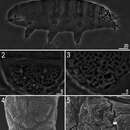Description
provided by Zookeys
(measurements in Table 1). Adults. Body transparent/white (after preparation), eyes present in 6 of 15 (40%) specimens mounted in Hoyer’s medium (Fig. 1). Dorsal cuticle sculptured: from head to legs II without tubercles but clearly thickened, from legs II to the caudal end of the body (including legs IV) with irregular tubercles and platelets. Tubercles increasing in size from the anterior to the posterior part of the body, reaching maximum dimensions between legs III and IV, where tubercles sometimes merge and form irregular platelets (Figs 2–5). Irregular tubercles 1.0–6.0 μm in diameter. Ventral cuticle smooth (i.e. without sculpturing). Gibbosities and cuticular pores absent.
Measurements and pt values of selected morphological structures of Hypsibius cf. scabropygus Cuénot, 1929 mounted in Hoyer’s medium (N – number of specimens/structures measured, RANGE refers to the smallest and the largest structure among all measured specimens; SD – standard deviation). CHARACTER N RANGE MEAN SD µm pt µm pt µm pt Body length 14 183 – 293 808 – 1132 235 949 33 97 Buccopharyngeal tube Buccal tube length 15 22.0 – 28.2 – 24.6 – 2.0 – Stylet support insertion point 15 12.0 – 15.9 51.3 – 57.1 13.5 54.9 1.1 1.6 Buccal tube external width 15 1.5 – 2.0 6.5 – 8.0 1.8 7.2 0.2 0.5 Buccal tube internal width 15 0.6 – 0.9 2.1 – 3.4 0.7 2.7 0.1 0.4 Placoid lengths Macroplacoid 1 15 1.8 – 3.2 7.7 – 12.3 2.4 9.6 0.4 1.3 Macroplacoid 2 15 1.7 – 2.7 7.2 – 11.3 2.2 8.9 0.3 1.1 Macroplacoid row 15 4.7 – 6.3 19.1 – 26.5 5.3 21.7 0.5 1.8 Claw 1 lengths External base 14 2.2 – 4.5 9.1 – 17.2 3.5 14.1 0.7 2.1 External primary branch 14 4.0 – 8.8 18.2 – 36.1 6.9 28.1 1.5 5.0 External secondary branch 14 2.3 – 5.9 10.5 – 24.4 4.4 17.9 1.0 3.9 Internal base 12 2.1 – 4.1 9.3 – 15.5 3.3 13.4 0.6 1.8 Internal primary branch 12 3.8 – 5.9 16.0 – 23.5 4.8 19.3 0.6 2.0 Internal secondary branch 12 2.4 – 4.3 9.9 – 16.5 3.3 13.3 0.6 2.0 Claw 2 lengths External base 11 3.0 – 5.2 12.4 – 19.9 4.1 16.7 0.7 2.2 External primary branch 13 6.7 – 10.4 29.7 – 43.7 8.5 34.7 1.3 4.4 External secondary branch 13 4.3 – 6.7 19.0 – 27.2 5.4 21.9 0.7 2.6 Internal base 10 2.4 – 4.5 10.9 – 18.9 3.6 14.6 0.7 2.2 Internal primary branch 12 4.0 – 6.7 17.7 – 27.2 5.4 22.0 0.9 2.9 Internal secondary branch 12 2.6 – 5.4 11.8 – 22.0 4.1 16.7 0.9 3.0 Claw 3 lengths External base 9 2.7 – 6.2 11.9 – 23.8 4.3 17.3 1.0 3.5 External primary branch 9 7.2 – 10.4 29.3 – 43.7 8.8 35.7 1.1 4.4 External secondary branch 9 3.6 – 6.5 12.8 – 27.3 5.2 21.0 1.0 4.3 Internal base 11 2.3 – 4.1 10.5 – 17.2 3.4 13.9 0.6 1.9 Internal primary branch 13 3.8 – 6.5 17.3 – 27.3 5.4 21.8 0.9 3.1 Internal secondary branch 12 2.7 – 6.1 12.2 – 24.8 3.9 16.0 0.9 3.5 Claw 4 lengths Anterior base 13 3.3 – 5.6 12.8 – 20.1 4.1 16.8 0.6 2.2 Anterior primary branch 13 4.4 – 7.5 19.5 – 31.1 5.9 24.2 1.1 3.9 Anterior secondary branch 11 3.1 – 13.2 13.0 – 47.3 4.8 18.9 2.9 9.7 Posterior base 12 2.7 – 5.4 12.3 – 21.5 4.5 18.2 0.9 3.1 Posterior primary branch 12 4.9 – 14.9 22.0 – 60.6 10.3 41.9 2.9 11.2 Posterior secondary branch 12 4.0 – 6.5 15.4 – 25.6 5.2 21.2 0.9 3.4
Bucco-pharyngeal apparatus of the Hypsibius type, without the ventral lamina, and with forked apophyses for stylet muscles (Fig. 6). Peribuccal lamellae absent. Teeth in the oral cavity armature absent or not visible under PCM. Pharyngeal bulb with apophyses and with two granular macroplacoids (both, without constrictions). Macroplacoid length sequence 2<1. Microplacoid and septulum absent.
Claws of the Hypsibius type, internal claws much smaller and of a different shape than the external claws (Fig. 7). All main branches with large accessory points. Smooth, indistinct areoles under claws usually visible only on posterior claws IV. Cuticular bars under claws I-III absent but a small bar is present near the posterior claw IV (Fig. 7, arrow).
Eggs. Unknown.
- license
- cc-by-3.0
- copyright
- Krzysztof Zawierucha, Jakub Dziamięcki, Natalia Jakubowska, Łukasz Michalczyk, Łukasz Kaczmarek
- bibliographic citation
- Zawierucha K, Dziamięcki J, Jakubowska N, Michalczyk , Kaczmarek (2014) New tardigrade records for the Baltic states with a description of Minibiotus formosus sp. n. (Eutardigrada, Macrobiotidae) ZooKeys 408: 81–105
- author
- Krzysztof Zawierucha
- author
- Jakub Dziamięcki
- author
- Natalia Jakubowska
- author
- Łukasz Michalczyk
- author
- Łukasz Kaczmarek

